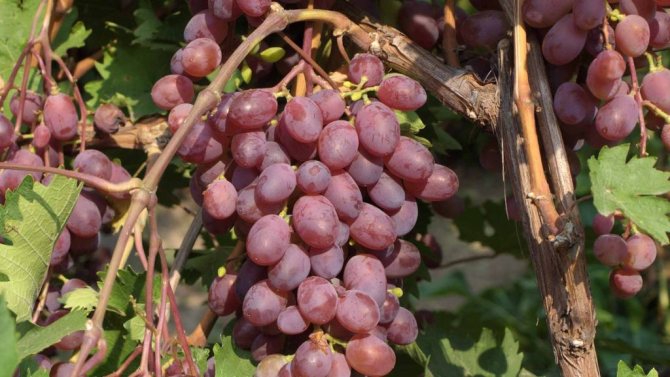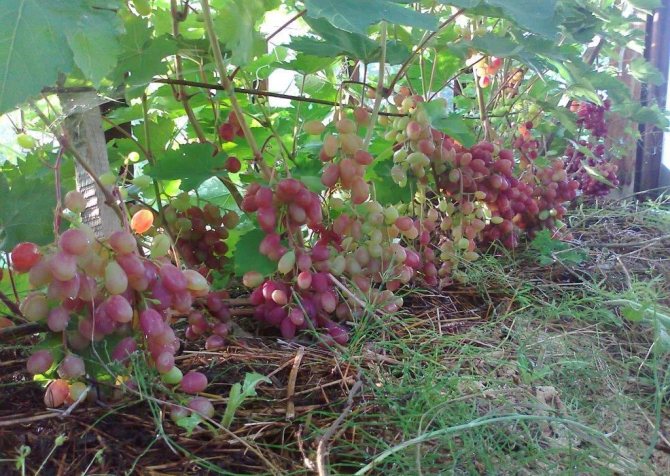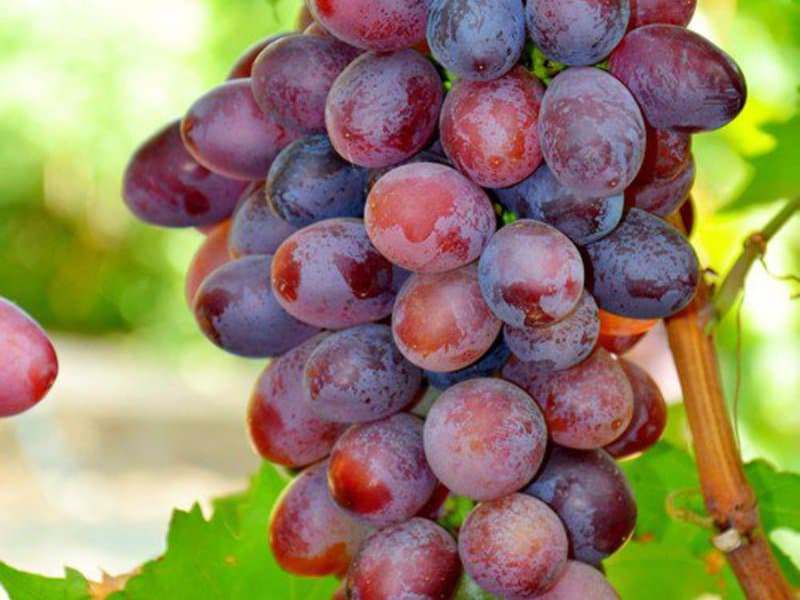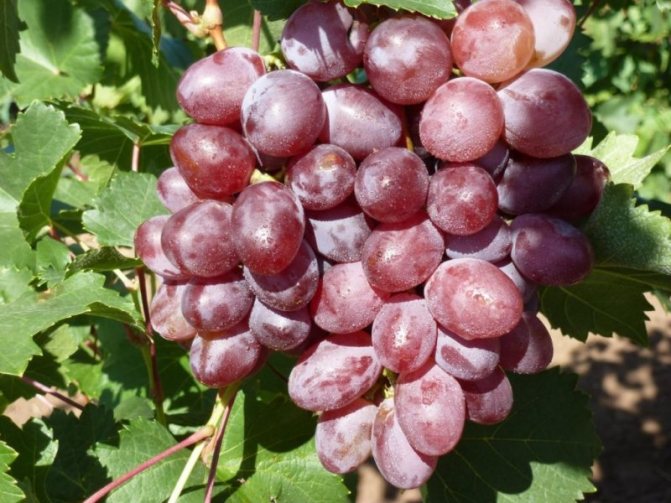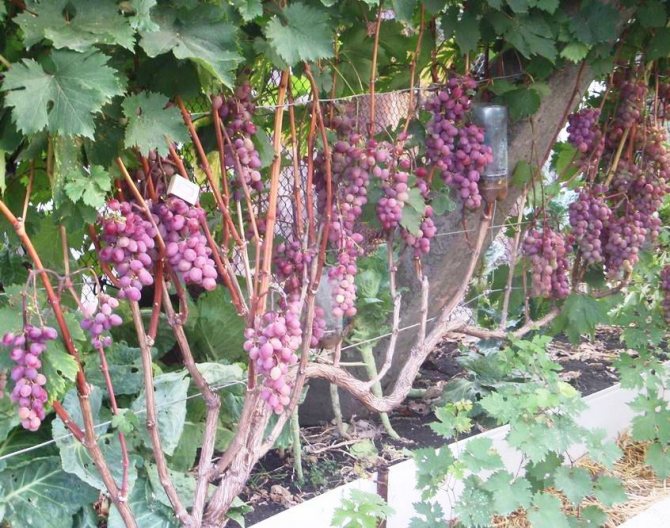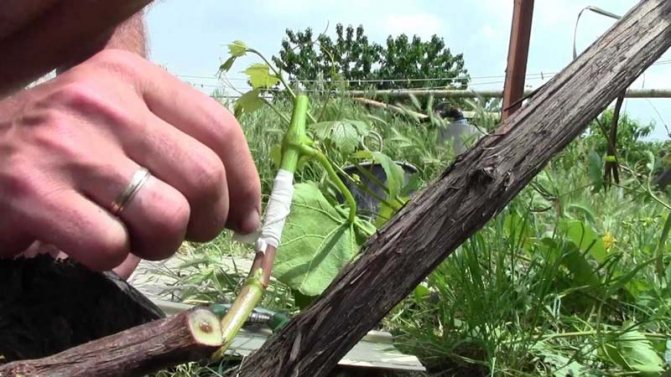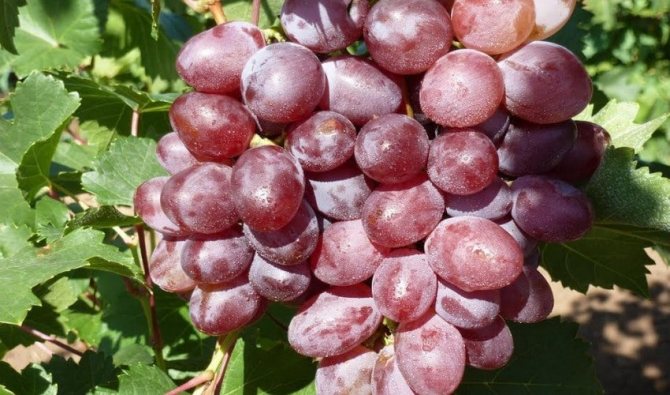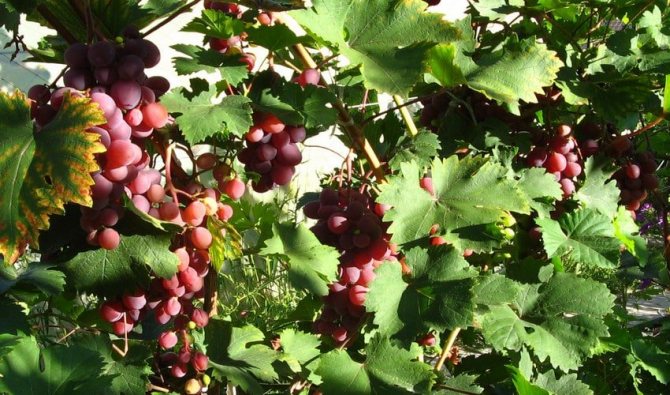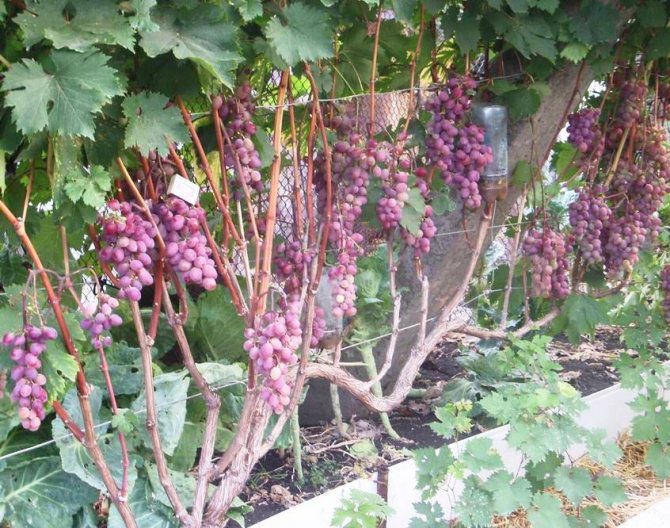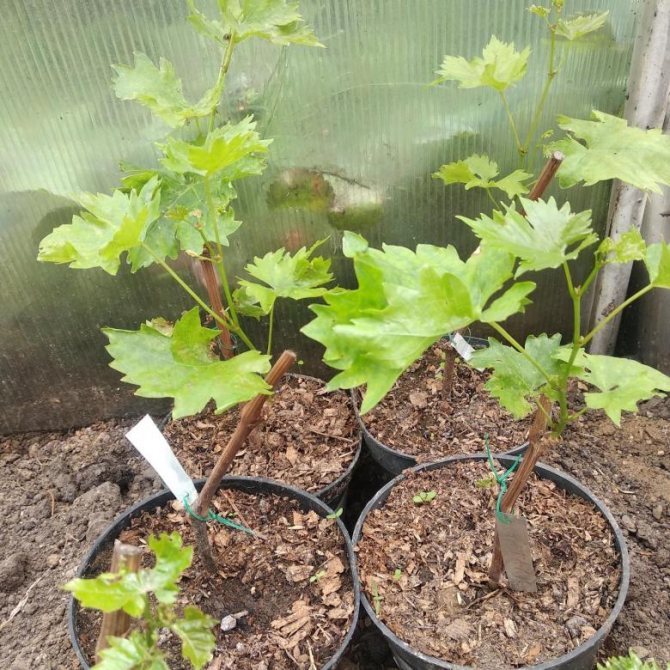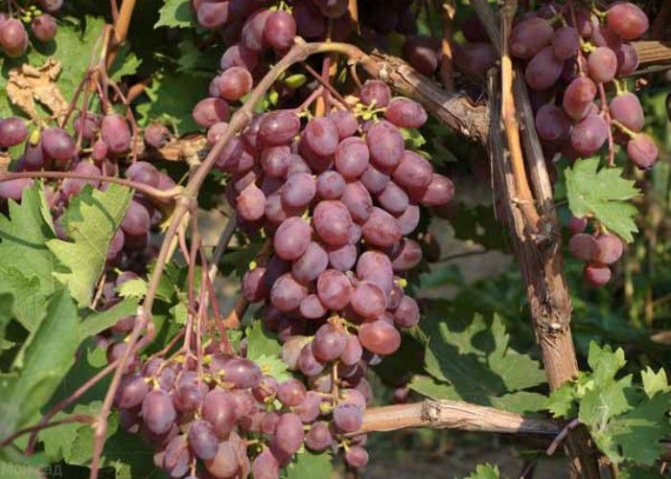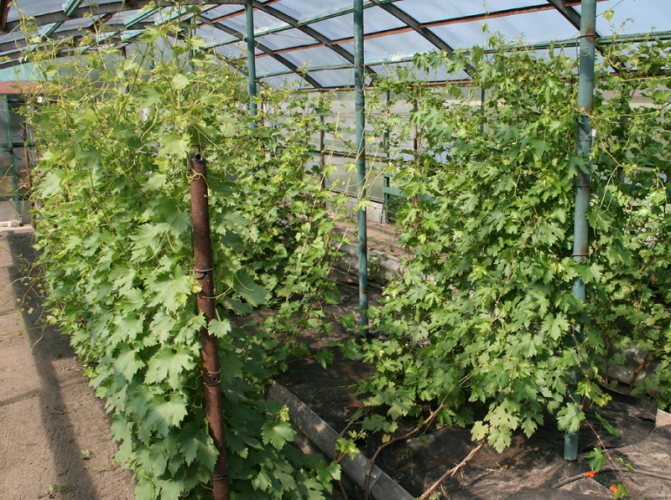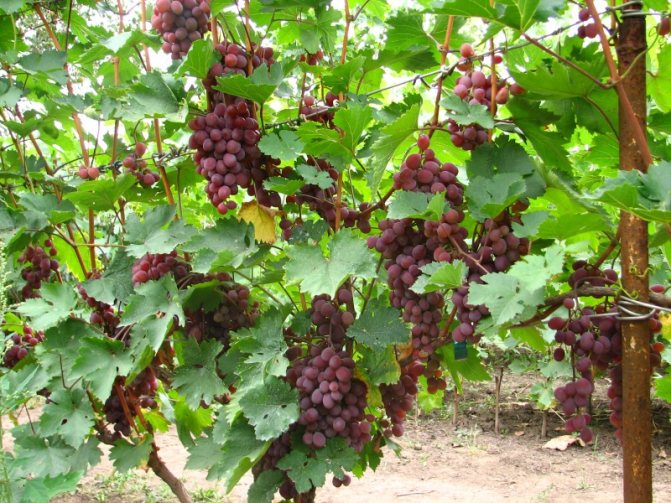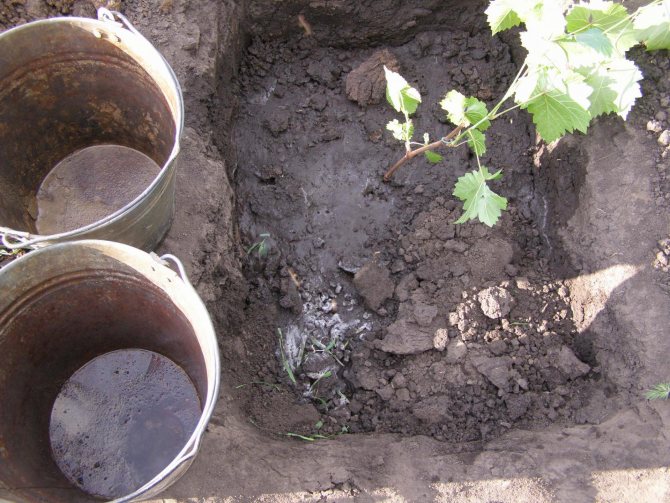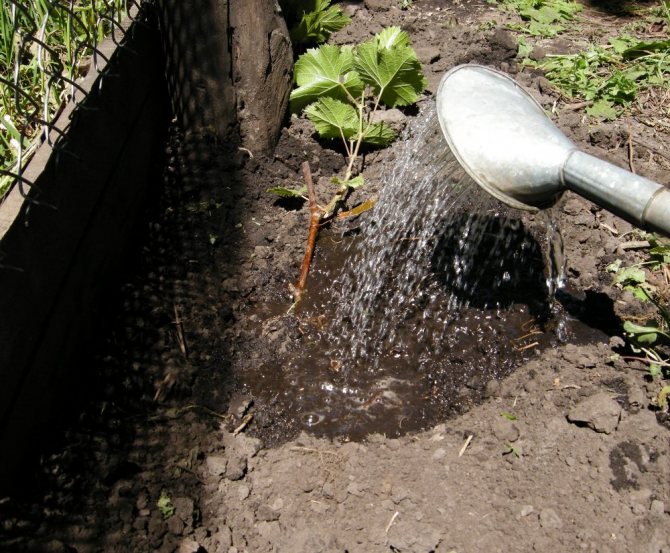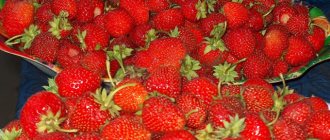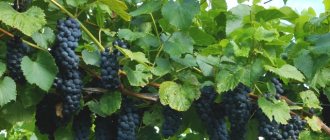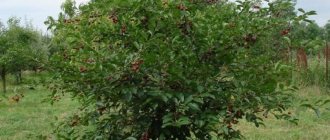Victoria cultivar characteristics table
| General information about the variety Victoria | |
| Parent couple Victoria | (Vitis vinifera x Vitis amurenzis) x SV 12-304 |
| The author of the variety: | VNIIViV named after Ya. Potapenko, Russia |
| Main features of Victoria | |
| Purpose: | dining room |
| Ripening time: | early |
| Productivity: | high |
| Taste: | harmonious, with nutmeg aroma |
| Color: | red-crimson |
| Frost resistance: | up to - 27 ° C |
| Description of a bunch of grapes | |
| Bunch weight: | 500-700 gr. |
| Density of the bunch: | moderately dense |
| Description of grapes | |
| Berry shape: | oval-ovoid |
| Berry weight | 6-7 gr. |
| Diseases | |
| Disease resistance: | Resistance to mildew 2.5 - 3.0 points, to powdery mildew 3.0 points. Affected by anthrocnosis at the beginning of the growing season |
There are a large number of completely different grape varieties. Among them, grapes with a sonorous and memorable name Victoria are quite popular. Gardeners and winegrowers love this variety mainly because it can be grown anywhere in Europe. Grapes can bear fruit even in areas with the most seemingly unfavorable climate.
Main characteristics
"Victoria" has not received official registration in the State Register of the Russian Federation, there is also no reliable data on its licensing and certification in foreign sources. From advertising descriptions and reviews of amateur winegrowers from different countries, the most significant characteristics of the variety can be distinguished:
| Parameter | Characteristic |
| Culture | Grapes (Vitis Vinifera L.) |
| Variety | "Victoria" |
| Growing conditions | Gardening |
| Direction of use | Dining room |
| Flower type | Functional-female |
| Growth strength of bushes | Average |
| Ripening terms | Early ripe: first decade of August (115-120 days from the start of the growing season) |
| Period of consumption (shelf life of fruits) | Summer (autumn); in the refrigerator for more than 2 months |
| Early maturity | 4th year |
| Productivity of one bush per season | High - on average 25 kg (maximum up to 28-30 kg); in industrial plantings - 13-16 t / ha |
| The shape and weight of the bunch | Large, conical, medium dense, less often loose; weighing 500-700 g |
| Fruit shape and color | Large, sometimes cracking, not aligned in size, rounded ovoid, dark red, with a raspberry tinge. Firmly attached to the stem. The skin is dense, it is not felt when eating |
| Fruit weight | 6-7.5 g |
| Pulp | Fleshy, juicy, dense, crispy |
| Tasting assessment (taste) | Sweet, nutmeg taste |
| Purpose of fruits | Dessert type |
| Sustainability | Weakly affected by mildew (2.5 points out of 4) gray rot, powdery mildew; highly resistant to phylloxera |
| Winter hardiness | Withstands frosts down to -27 ℃ (in the northern and central regions requires shelter for the winter) |
| Registration in the State Register of the Russian Federation | Absent |
Diseases and their prevention
Grape "Victoria" almost does not suffer from fungal diseases of the vine. Its only drawback is the increased risk of anthracnose infection during the beginning of the growing season.
| Diseases | Sustainability |
| Downy mildew (mildew) | High, 6 points |
| Oidium | High, 5 points |
| Rot gray | High, 6 points |
| Anthracnose | Low, 2 points |
Having processed this grape with "Folkon" or another preparation of a similar action at the beginning of the growing season, you can forget about further spraying of this variety.The drug is bred according to the instructions and the vineyard is treated before and after the flowering of the vine.
Breeding history
This type of culture was bred in the early 70s of the last century by specialists from the All-Russian Research Institute of Viticulture and Winemaking named after V.I. Ya. I. Potapenko by interspecific hybridization: crossing a frost-resistant European-Amur hybrid (V. Vinifera L. x V. Amurensis) with a Seiv-Villar hybrid 12-304.
The hybrid form Save-Villar 12-304 is a direct manufacturer with complex resistance to diseases, phylloxera and frost, and is used for breeding purposes.
Due to a number of advantages obtained from parental forms, "Victoria" is often used as a donor of valuable qualities, not only by professionals, but also by amateur breeders to develop new grape varieties. Practical results of the enthusiastic winegrower Evgeny Georgievich Pavlovsky would do honor to another scientific institution. He created 26 new varieties, including such masterpieces of amateur selection as "Cherry" ("Victoria" x "Rizamat"), "Veronica" and "Beauty" ("Victoria" x a mixture of pollen of European-Amur forms).
Detailed information about some of Pavlovsky's novelties can be obtained from the following video:
These hybrids are not only successfully grown in private farms in various regions of Russia, but also attracted the attention of producers, including some European countries. However, without proper testing, recognition of new forms by varieties and entry into the State Register of Breeding Achievements, the way for them to commercial vineyards is still closed.
At present, the possibilities of growing this type of culture are being evaluated on experimental plots in the soil and climatic conditions of the southern and central regions of Belarus, the Kemerovo region of our country.
Seasonal maintenance, pruning and fertilization
Mandatory seasonal manipulations with Victoria grapes: pruning, fertilizing, pulling out weeds, treating parasites, mulching, loosening the soil and, finally, pruning. Pruning is carried out in the fall if the plant is more than 5 years old. Up to 5 years of age, spring pruning is indicated in order to stimulate the growth of active shoots. In total, up to 10 strong shoots should remain on the bush.
Fertilizers are applied twice a year, using organic matter (manure, humus) or complex fertilizers. First application: before flowering, second: after picking berries. Disease treatment is also performed before flowering.
Description of the plant and the specifics of growing
Vine of medium vigor, with well-ripening shoots. The perennial parts of the bush are covered with reddish, coarse-fibrous bark. Fruitful shoots from 70 to 80%, on average, the load on each is 1.4 bunches (maximum - 1.8).
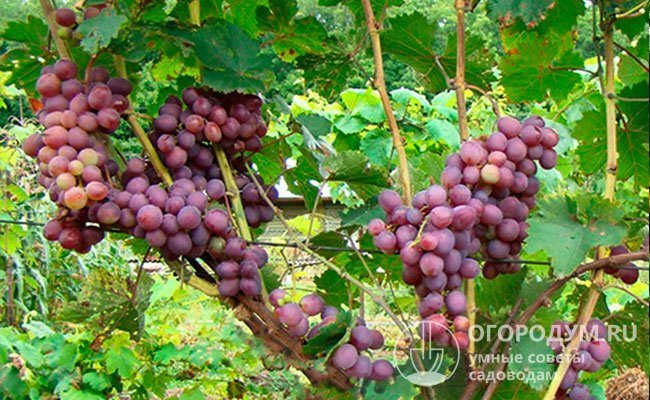
Low-growing bushes with well-ripening shoots
Leaves are simple, medium-sized, five-lobed, slightly dissected, dark or light green, smooth, dull. The petiole notch is open, with a sharp bottom and a neatly cut toothed edge. The flowers are slightly greenish, small (3-5 mm in diameter). A distinctive feature of "Victoria" is the functional-female type of flower. For stable fruiting, joint planting is necessary with specially selected bisexual pollinating varieties that bloom at the same time. The best for this type of culture are "Platovskiy", "Kristall", "Augustine" and others. The Ukrainian gardener tells about the influence of pollinators on the size, shape and color of berries in a video:
Experienced growers do not advise leaving thin shoots that have grown from the head of the bush for fruiting. The pruning length of the fruit arrows has a significant effect on the yield of the plant and the quality of the fruit. It is considered advisable to cut short - by 2-4 buds, or medium - by 6-8.
For "Victoria" it is recommended to leave about 25-30 healthy eyes per bush, when cultivated as a two-armed cordon, including: planting according to the 3x2-2.5 m scheme, growing two mature strong shoots; the creation of a twisted stem from them to two tiers of trellis wire at a height of 0.5-1 m; the formation of two horizontal arms of the cordon with fruit links, the attachment of green shoots to the wire of the third tier of the trellis, followed by free hanging.
Features of the Victoria variety
Victoria grapes, for all their virtues, have a tendency to peel and crack berries. Excessive nitrogen fertilizers and moisture in the soil can contribute to cracking. Abundant watering after a prolonged drought is especially dangerous. The berries are intensively absorbed into the water, which inevitably leads to cracking of the skin. If a lot of berries burst on the brush, it is better to immediately cut it off from the bush so as not to attract insects.
To prevent peeling, you need to monitor the load of the fruit arrow and thin out excess brushes. Berries can also become smaller if there is no pollinator, in which case the problem is solved by planting bisexual grape varieties nearby, the flowering period of which coincides with Victoria.
Productivity and ripening time
The plant gives the first signal harvest in the 2-3rd year after planting, marketable fruiting begins in the 4th - on average, about 30 kg from one bush.
Removable maturity occurs 115-120 days after bud break... The bunches can remain on the bush for a long time, the quality of the fruit does not deteriorate.


The berries are firmly held on the stalks and do not crumble even with a late harvest
The taste and aroma are revealed in the first decade of August. When picked correctly, the fruits do not deteriorate and can be stored well in the refrigerator for more than 2 months. The juicy pulp is perfectly protected from damage by the dense skin, which is practically not injured during transportation, therefore the variety is considered promising for industrial cultivation for commercial purposes.
The opinion of an experienced Ukrainian gardener about the yield potential can be found in the following video:
Features of agricultural technology and disease resistance
Victoria grapes are distinguished by their early maturity. He gives the first harvest already 2 - 3 years after planting the seedlings. The best planting time is autumn, October. Before frost, the seedling must have time to take root. In the first year of Victoria, good shelter is required: special nonwovens, dusting with dry earth, mulching of the root zone. Mature plants overwinter under a lightweight shelter.


We will not describe all the generally accepted rules for planting and caring for grapes, but immediately move on to the nuances inherent in a particular variety.
Due to the tendency of the variety to crack ripening berries, watering must be carried out correctly. With the onset of the ripening period (August), artificial watering is completely excluded, but only if precipitation is present. If there is a drought, then moderate watering is needed. Otherwise, when it rains, a sharp drop in the level of soil moisture will provoke cracking of the peel of the berries.
Advice! To control the moisture of the soil under the grapes and avoid waterlogging in the rainy summer, install a seasonal shelter or greenhouse over the vineyard.
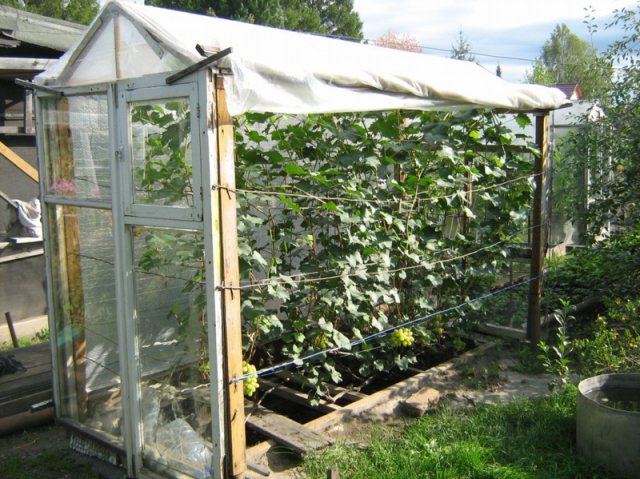

During the growing season, it is recommended to apply organic fertilizers and wood ash under the grapes (in the spring and before flowering). Victoria responds well to leaf dressing with chelated microelements, which increase disease resistance, improve the taste of berries.
Due to the functional feminine bloom, Victoria grapes are prone to overload. Productivity must be formed, leaving no more than 30 eyes to one bush (if fruit shoots have 5 - 8 eyes).The number of clusters on one shoot is also normalized, the average number is 1.8.
To get a full-fledged beautiful bunch, growers carry out “combing out” it with a paint brush at the beginning of berry growth. This procedure removes weak, underdeveloped, damaged ovaries. At first, the bunch looks bare and too sparse, but as the berries grow, it acquires an excellent presentation.
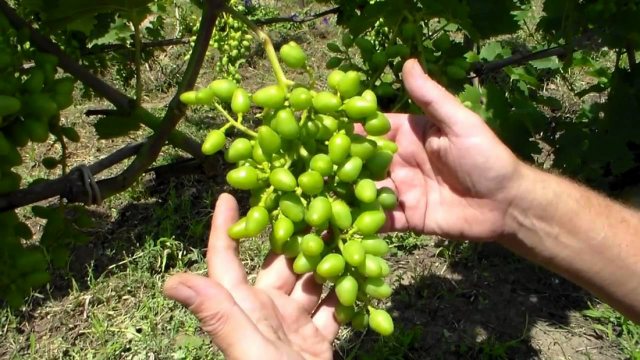

In Victoria, which forms clusters prone to decay, mold, damage by wasps, the lower brushes should not be left. From them you will not get an increase in yield, but you will create an excellent breeding ground for diseases and bait for insects.
The fan-shaped method of forming the bush is preferable to the variety, providing better ventilation. To protect against wasp raids, summer residents use crops of spicy herbs, cover the bunches with bags of mesh or gauze.
Advice! Check the bunches regularly during the ripening period and immediately remove any cracked berries.


Fruit characteristics
The bunches are conical, of medium density, sometimes loose, weighing about 500-700 g. The berries are large, weighing 6-7.5 g. In the main collection, the fruits are oval or ovoid in shape. Skin color from bright red to crimson. The skin is firm but easy to eat.
During the ripening period, especially in high humidity conditions (rainy weather or waterlogged soil during watering), the variety tends to crack berries, after which wasps and hornets seriously damage them.


To prevent cracking of the berries, it is recommended to use drip irrigation systems and mulch the soil under the bushes
The pulp is juicy, fleshy, dense, crispy, sweet, with a nutmeg aftertaste. The number of seeds (seeds) in the pulp of berries is very small - 1-3 pieces. Taste qualities of "Victoria" according to gardeners' reviews are simply excellent, harmoniously combining sugar content (17-18%) with pleasant sourness (5-6 g / l). Most summer residents find the taste "refreshing" nutmeg and call it "amazing" grape.


Dessert fruits (universal) are great for fresh consumption, they are used for making jams, confitures, compotes, juices, raisins and other processing methods
Planting grapes
Despite the genetic predisposition of the variety to high fruiting, the quantity and quality of the future harvest largely depends on the choice of planting material, the timing and technique of its rooting.
Optimal timing
You can plant grapes in the spring, when the soil warms up, and in the fall, before the first frost. With autumn rooting, the bush will have time to get stronger by spring and will not suffer from drought. The main thing is to plan the landing at least 2 weeks before the temperature drops.
If the vine is planted in March - April, weak seedlings may die or dry out due to weathering of soil moisture. In addition, such specimens are characterized by late fruiting. Experienced gardeners advise planning the procedure for the last weeks of October.
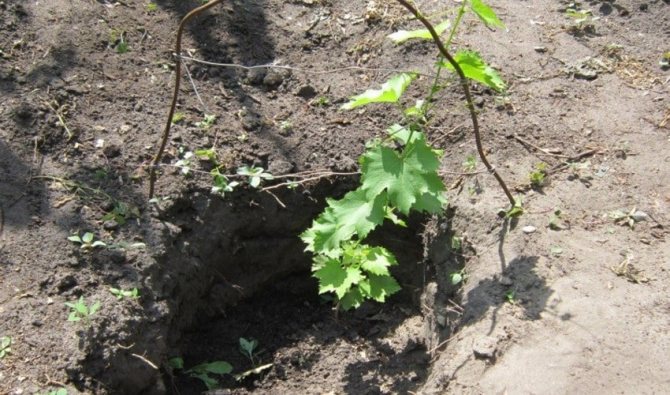

It is important to take into account that the bushes with foliage are suitable for planting only in the warm season. The adaptation can be accelerated by covering the plant with any covering material.
Did you know? Grape berries contain about 150 active substances and more than a dozen vital vitamins with a calorie content of 65 kcal.
Selection of seedlings when buying
"Victoria" of Russian selection requires special attention when choosing, because the same and similar varieties are on sale.
An authentic quality seedling is distinguished by:
- a smooth root system without outgrowths, galls and thickenings (the minimum number of root processes should correspond to 3);
- saturated brown color of the bark;
- an even powerful vine, the length of which should not be less than 20 cm;
- 6 well-developed dark brown buds.
It is better to make such purchases in garden centers and specialized shops with a good reputation. The product must have a tag with information about the variety and producer of the crop.
Traces of mold, putrefactive infection, mechanical damage, spotting are unacceptable on the planting material. From the offered assortment, it is worth giving preference to the strongest and most well-developed specimens. When avoiding grafts, choose specimens with a half-meter root. On self-root bushes, there must be at least one ten-centimeter shoot.
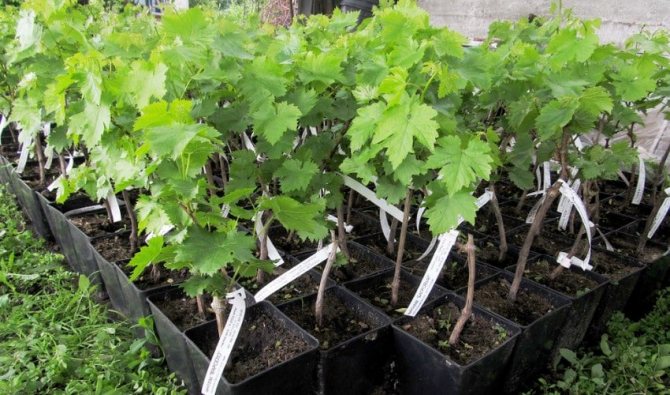

Site preparation and landing technology
The described variety is characterized by increased requirements for lighting and protection of the site from winds and drafts. The best place for him would be a corner open to sunlight.
Preparatory procedures for the autumn planting of grapes need to be planned a month in advance, and in the case of spring rooting, it is better to start them in the fall.
To this end:
- garbage is removed at the selected site;
- dig a hole 80 cm deep and wide;
- its bottom is covered with a five-centimeter layer of rubble;
- about 10 cm of fertile soil is poured on top;
- then fill the recess with 2 buckets of compost or chicken droppings;
- re-sprinkle all layers with a fertile substrate (up to 10 cm high);
- mix everything with a shovel;
- cover the pit with polyethylene, securely fixing its edges, and leave it to form a specific microclimate.
Important! When rooting grapes, add superphosphate granules to the pit, but it is important to combine all fertilizers in a priority order and only after that pour out the earth
.
Planting grape seedlings is carried out according to the following algorithm:
- Dip the seedling in a container of water for several hours. If you wish, you can add a growth stimulator to it - "Kornevin", "Emistim", "Ecosil".
- To prevent the root system from drying out, treat it with a clay mash.
- Open the prepared hole and remove the soil layer from it so that the roots are comfortable in the formed depression.
- Water the hole until the soil absorbs moisture.
- Lower the seedling into the hole to the level of the root collar (conventionally, it is located just above the roots) and straighten the root processes. They must go deep into the ground - otherwise the plant will not overwinter.
- To exclude the slope of the vine, a wooden stake can be dug into the ground, to which a seedling can be tied in the future.
- Cover with substrate and tamp thoroughly.
- Make sure that 2 eyes rise above ground level. If we are talking about a grafted bush, the grafting site should be 3 centimeters above the soil.
- Mulch the trunk circle with sawdust, straw or peat.
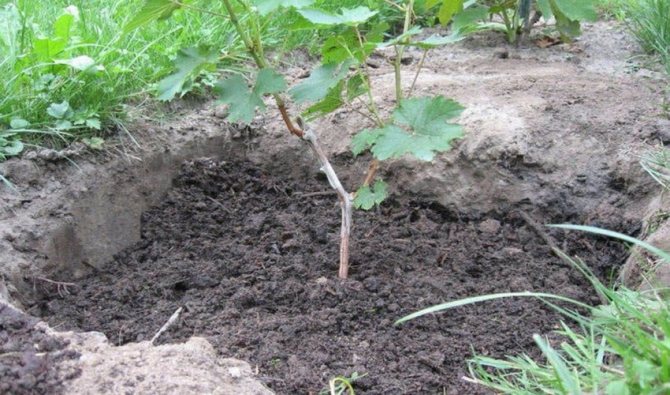

Advantages and disadvantages of the variety
Main problems, which gardeners may encounter when growing "Victoria" - the tendency of berries to cracking and slight peas, the need to plant nearby pollinator varieties with similar flowering periods.
To numerous weighty merits varieties include: large fruits with a nutmeg flavor, high frost resistance and yield, the ability to maintain marketability when transported over long distances. In addition, according to the reviews of experienced winegrowers, this type of culture is slightly affected by mildew, gray rot, oidium and is highly resistant to phylloxera.
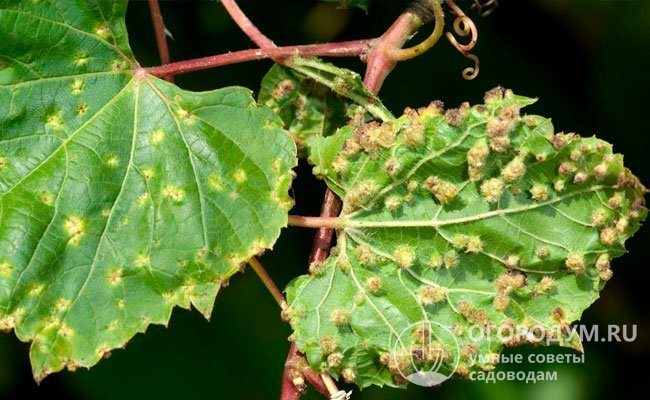

Grape leaves affected by phylloxera (grape aphid) - one of the most common crop pests
Diseases. Pests
Diseases in the Victoria grape variety are the most common and common among other varieties. Very often, the variety is exposed to various types of fungal diseases:
- The mealy race very often becomes a problem for many fans to grow Victoria on their land. The fungus affects the entire plant: dark spots on the leaves and trunk, the berries are covered with a white coating, an unpleasant odor.
- Gray and white rot can also attack grapes. The disease occurs in humid and warm weather, it is a serious enemy for the entire crop.
- The plant may lack chrolophyll due to chlorosis. The leaves become dull and the fruit does not develop well. This can be cured with a drug that contains iron, which can be purchased at a specialist store.
In addition to infections, a serious enemy for the Victoria variety is wasps, which constantly fly around the fruits. They can severely spoil and even destroy the berries if not dealt with. In order to protect the bunches from insects, you can make cases of thin fabric, which will restrict the wasps' access to the fruit.
Victoria grapes, despite all their disadvantages, are popular. Its berries are very tasty, so growers are ready to come up with new ways to make it easier to care for the plant, but just not abandon this variety forever.
Gardeners reviews
Alexander, 47 years old, Rostov region
I don't particularly admire Victoria. We have three bushes growing in our dacha - all of which are rooted. The vigor of the plant is much weaker than that of Laura. The elegant color and sweet taste of the berries, the high frost resistance and productivity of these grapes, I appreciated only in the fourth year. Last season, the wasps hit the bunches badly, leaving only an empty skin from some berries. From these annoying insects, I set sweet traps, put on nylon bags on the brushes. All my efforts were crowned with temporary success. Even with a slight waterlogging of the soil, the berries begin to crack, instantly becoming a powerful bait for wasps.
Valentin, 56 years old, Kharkiv region
I am growing the variety for the eighth season. When planting a vineyard, he was the first on the list. I liked it very much for its taste, and outwardly the vine is a real beauty. It was upsetting that after the rains, during the ripening period, the berries burst. But a couple of years ago I tried to cover the soil with newsprint and covered it with grass. Under such mulch, it practically stopped cracking. In addition, in recent years, I have not rationed the harvest in bunches and noticed that there are fewer cracking berries. There are almost no pea fruits, sometimes a small part of the bunches turns out to be sparse, but this does not affect the nutmeg, inimitable taste at all. Victoria overwinters perfectly, for all the time she has never froze even once, she gets sick extremely rarely, she is unpretentious in her care, so there is not much trouble with her.
Roman, 38 years old, Pyatigorsk
I was disappointed with the first "signaling" on young Victoria saplings (average taste, disheveled bunch), I wanted to uproot them. But now I'm glad I didn't. The taste has become excellent, I pollinate with a down jacket. Among the advantages is its undemandingness to the soil. Last year I bought some kind of "left" vermicompost and fertilized several varieties on the site, after which they began to have severe chlorosis, and Victoria did not suffer at all. When damaged by recurrent spring frosts, the variety recovers well from replacement buds.
Choosing a site for planting, taking into account the type of soil, watering
Loamy soils are ideal for Victoria; clay or sandy soils are also suitable. Like other varieties, if the soil is not suitable for the plant, the berries grow small or not sweet enough. It is necessary to plant Victoria grapes in an open area with a support. The distance to the neighboring plant is at least 1.5 m. Young seedlings are placed in previously dug holes 80 cm in diameter and 80 cm in depth. After planting, water the plant, and be sure to cover it with mulch. For planting, it is recommended to buy two-year-old seedlings (as practice shows, they have the highest survival rate in the ground).
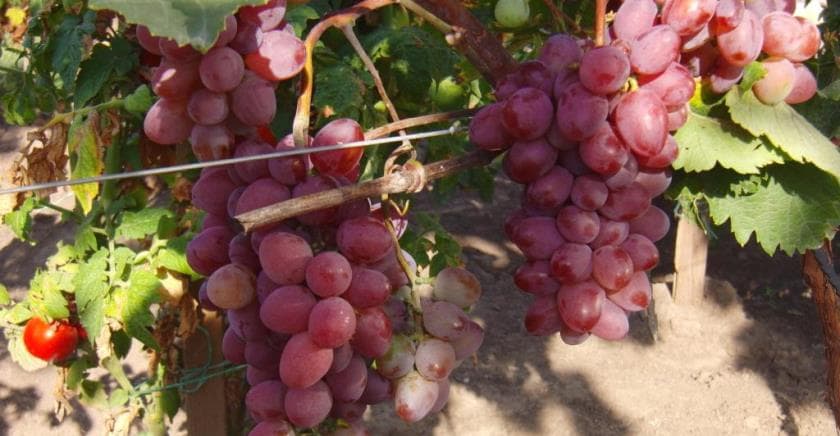

History and zoning of Victoria grapes
The birthplace of grapes is the city of Novocherkassk, where Victoria was bred by Russian breeders. The variety is obtained as a result of crossing several varieties of culture, therefore it belongs to the category of hybrids.
The description of the variety is very similar to the Japanese grape varieties that were harvested at Uehara Station. By the way, this is what this variety was originally called. It is worth noting that Victoria grapes exist in many countries of the world, but their properties differ from those of the domestic variety.
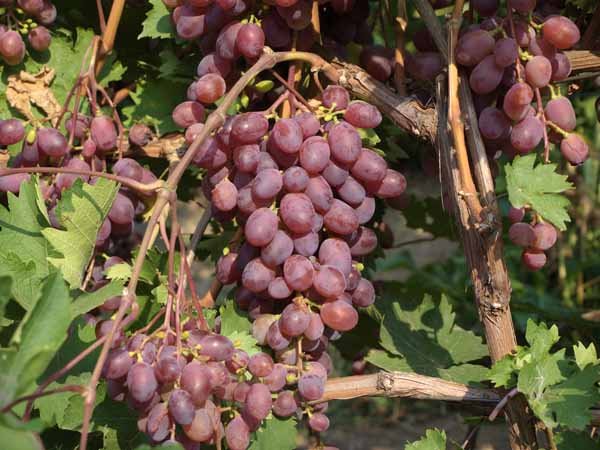

Victoria grapes are considered an excellent variety for growing in the garden.
The frost resistance that Victoria grapes possess determines the recommended growing regions:
- Ural;
- Siberia;
- Volga region;
- Moscow region.
However, the frost resistance of the variety does not exclude the need for a winter shelter. In this matter, one should focus on the growing region. In northern latitudes, good insulation is required, in southern latitudes, grape bushes do not need additional shelter.

